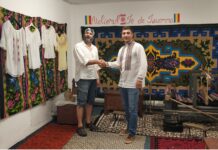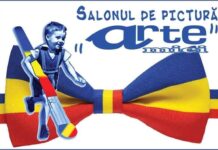[:ro]
UNIVERSURI PALPABILE/ PALPABLE UNIVERSES/ SPÜRBARE UNIVERSEN

Michael Lassel este artistul mondial, rafinat și sensibil al timpului nostru, iar culoriile Domniei Sale pot participa, direct, la compunerea universală a sufletului, mai presus decât orice artă poetică. Fără nici un dubiu pânzele Domniei Sale cresc flori de argint, aur și metaforă pe stelele permise vieții și aduc precizii milimetrice sentimentale, ce pot fi arhivate ca antologii vitale de spontaneitate.
Michael Lassel este sortit să aducă pe lume ”UNIVERSURI PALPABILE” și să le pună într-o ordine originală, fără ca actul creației sale să inventeze procesul vieții, morții, orgoliului, timpului, timidității și umanității.
Expoziția, de pe simezele GALLERY13.RO, nu este o aventură ci este o mișcare, care, cu semnificații directe poate atinge parabolicul, nevoia de baroc, de răscruci, de istorie și realism îmblânzit.
Michael Lassel este, și, spațiul de magie al secolului tău!

——————–
Michael Lassel s-a născut pe 19 decembrie 1948 în Ludwigsdorf / Transilvania. A urmat mai întâi școala la Sächsisch-Reen, apoi a urmat liceul de artă din Neumarkt / Târgu Mures, iar în cele din urmă, din 1968 până în 1972, a studiat la Academia de Artă din București. În 1986 a emigrat în Germania împreună cu familia sa. Michael Lassel s-a orientat insistent către trompe-l’oeil din 1989 când s-a alăturat grupului de artiști francezi „Trompe-l’oeil / Réalité” (sau „Trompe-l’oeil de chevalet”) și a participat la expozițiile lor. A primit numeroase premii pentru lucrările sale, începând cu „Médaille d´Or et le Grand Prix Robert Vrinat” de la Metz în 1990 și premiul I al Academiei Europene de Artă din Luxemburg în 1991. El și-a expus lucrările în muzee și galerii din întreaga lume. Lassel este unul dintre artiștii nu tocmai rari care au optat pentru un grup limitat de motive. Sunt produse ale civilizației care nu sunt prezentate într-o secvență izolată, ci mai degrabă aranjate într-un tot artificial ca o colecție densă de lucruri care atrage inevitabil privirea întrebătoare a observatorului. Aranjamentul spațial al piramidei obiectului central, care subliniază formatul vertical al imaginii, urmează modele clasice. Tipurile de obiecte folosite corespund și cărților, instrumentelor de suflat, monedelor și bancnotelor cunoscute din arta naturii olandeze din secolul al XVII-lea, imagini, busturi, vase de băut, ceasuri și multe altele, doar că Lassel și-a cumpărat modelele la piețele de vechituri din zilele noastre.
Michael Lassel – Icoane pentru mileniul trei de Johann Adam Stupp
[EN]
Michael Lassel is the world artist of our time, refined and sensible, and the colors of his Majesty can participate directly in the universal composition of the soul, above any poetic art. Undoubtedly, His Majesty’s canvases grow silver flowers, gold, and metaphor on the stars and bring sentimental millimetric precision, which can be archive as vital anthologies of spontaneity. Michael Lassel is doomed to bring into the world „PALPABLE UNIVERSES” and to put them in the original order, without the act of his creation inventing the process of life, death, pride, time, shyness, and humanity. This exhibition is not an adventure but a movement with direct meanings that can reach the parabolic, the need for baroque, crossroads, history, and tamed realism. Michael Lassel is also the magic space of your century!
——————–
Michael Lassel was born on December 19th, 1948 in Ludwigsdorf / Transylvania. He first went to school in Sächsisch-Reen, then he attended the arts high school in Neumarkt / Târgu Mures, and finally from 1968 to 1972 he studied at the Art Academy in Bucharest. In 1986 he emigrated to Germany with his family. Michael Lassel turned emphatically to the trompe-l’oeil from 1989 when he joined the French artist group „Trompe-l’oeil / Réalité” (or „Trompe-l’oeil de chevalet”) and took part in their exhibitions . He has received numerous prizes for his work, beginning with the “Médaille d´Or et le Grand Prix Robert Vrinat” from Metz in 1990 and the 1st prize of the European Art Academy in Luxembourg in 1991. He has exhibited his works in museums and galleries all over the world. Lassel is one of the not exactly rare artists who have opted for a limited group of motifs. They are products of civilization that are not presented in an isolated sequence, but rather arranged into an artificial whole as a dense collection of things that inevitably attracts the observer’s questioning gaze. The spatial arrangement of the central object pyramid, which emphasizes the vertical image format, follows classic models. The types of objects used also correspond to the books, wind instruments, coins and bills known from Dutch still life art of the 17th century. Images, busts, drinking vessels, clocks and more, only that Lassel bought his models at the flea markets of our day.
Michael Lassel – Icons for the third millennium by Johann Adam Stupp
[DE]
Michael Lassel wurde am 19.12.1948 in Ludwigsdorf / Siebenbürgen geboren. Zur Schule ging er zunächst in Sächsisch-Reen, dann besuchte er das musische Gymnasium in Neumarkt/Târgu Mures, um schließlich von 1968 bis 1972 an der Kunstakademie in Bukarest zu studieren. 1986 emigrierte er mit der Familie nach Deutschland. Dem Trompe-l‘oeil wandte sich Michael Lassel nachdrücklich ab 1989 zu, als er sich der französischen Künstlergruppe „Trompe-l’oeil / Réalité” (bzw. „Trompe-l‘oeil de chevalet”) anschloss und sich an deren Ausstellungen beteiligte. Für sein Schaffen erhielt er zahlreiche Preise, beginnend mit der „Médaille d´Or et le Grand Prix Robert Vrinat” aus Metz 1990 und dem 1. Preis der Europäischen Kunstakademie Luxemburg 1991. Seine Werke stellte er in Museen und Galerien in der ganzen Welt aus, wobei außer dem British Museum in London auch noch Galerien in Paris, New York und Singapur besonders hervorzuheben sind. Lassel gehört zu den nicht eben seltenen Künstlern, die sich für eine eingeschränkte Motivgruppe entschieden haben. Es sind Erzeugnisse der Zivilisation, die nicht in isolierter Reihung, sondern zu einem künstlichen Ganzen arrangiert vorgestellt werden als eine dichte Ansammlung von Dingen, die unweigerlich den fragenden Blick des Betrachters auf sich zieht. Die das vertikale Bildformat nachdrücklich betonende Raumanordnung der zentralen Gegenstandspyramide folgt klassischen Vorbildern. Auch die beigezogenen Objektarten entsprechen den schon aus der holländischen Stilllebenkunst des 17. Jahrhunderts bekannten Büchern, Blasinstrumenten, Geldmünzen und -scheinen, Bildern, Büsten, Trinkgefäßen, Uhren und anderem mehr, nur dass Lassel seine Modelle auf den Flohmärkten unserer Tage erworben hat.
Michael Lassel – Ikonen für das dritte Jahrtausend von Johann Adam Stupp
CLICK PENTRU A VEDEA EXPOZIȚIA VIRTUALĂ/ CLICK TO SEE VIRTUAL EXHIBITION
https://www.gallery13.ro/ro/expozi%C5%A3ii/lepidus-universes-3/[:]






























